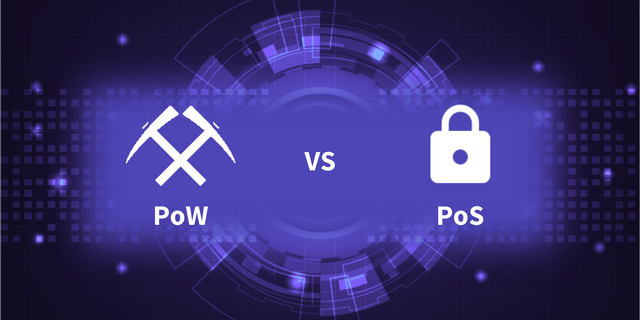Crypto Academy Season 3 Beginners' course - Task 4: Different types of Consensus Mechanisms. BY @hibbanbilal
Hello, Steemians! I hope you're all doing well? The third season of Crypto Academy ended last week, and this break is a fantastic time to complete the assigned fixed tasks. I am going to attempt task 4 which is given by Professor @sapwood

(1) What is the difference between PoW & PoS? Advantages & Disadvantages? Which one is better in scaling Capacity? Examples?

DIFFERCENCES BETWEEN PoW AND PoS
| PoW | PoS |
|---|---|
| Proof of work necessitates enormous amounts of energy, which only grows as more miners join the network. | Because the competition is between the highest number of stakes, Proof Of Stake does not demand much energy. |
| To get a prize, you'll need expensive equipment in addition to your brainstorming. | To receive a prize, you don't need any expensive equipment or any type of brainstorming. |
| Miners are rewarded for their efforts in validating new blocks by performing difficult calculations. | Miners are compensated based on the number of coins they stake. |
| Computing power determines a miner's ability to solve a puzzle fast in PoW. | The quantity of stake coin held by a user determines how soon a new block is validated in PoS. |

ADVANTAGES AND DISADVANTAGES
ADVANTAGES OF PoW :-
In PoW, every miner has the same chance of receiving the rewards and producing the next block. It's now up to the first person who can answer the question correctly.
PoW is given the utmost level of security through a complicated cryptographic puzzle-based hash function that is unique to each transaction.
PoW brings objectivity to a group of companions who all have different emotional viewpoints and goals. Without conversing with or confiding in outsiders, hubs in PoW blockchains may easily identify the valid chain to follow.
This is a completely decentralized system. This means that no single person has control over it. The system becomes more clear and accurate as a result of this.
DISADVANTAGES OF PoW :-
There was once a dream of PoW as "one CPU, one vote," but that vision faded as miners began to upgrade to GPUs and then ASICs, which are far more amazing and capable.
PoW is not environmentally friendly because the hardware devices used for mining produce a lot of noise, making premises where mining rigs are situated unlivable. Furthermore, there is significant speculation concerning environmental degradation.
In PoW, there is a high cost of electricity. Many miners are working on the same problem, but only the first miner who solves it successfully is taken into account. Furthermore, because the majority of electrical energy in the world today comes from fossil fuels, the entire process is not environmentally benign.
It takes a long time to get a good outcome because it has to be tested and validated all the time.
ADVANTAGES OF PoS:-
PoS security is predicated on a powerful driving force, with excavators or validators setting up a guarantee that may be revoked if they are detected operating dishonestly.
Anyone can mine and be rewarded with transaction fees, which reduces the need for centralization because anyone can be a token stakeholder and earn.
PoS is a stake-weighted consensus technique that was designed to overcome the proof-of-work mechanism's energy inefficiencies. As a result, it is an inefficient energy mechanism.
Because PoS is very scalable, it can handle as many transactions as feasible in a short period of time.
DISADVANTAGES OF PoS :-
PoS blockchains are newer, haven't held as much financial value as PoW blockchains, and are more complicated because they must replicate what PoW delivers with more plan selections and a more muddled standard set packed with possibilities.
PoS is a centralized system in which mining rights are proportional to the number of tokens staked. As a result, the more tokens you stake, the larger your mining block capacity will be.
There isn't a level playing field for everyone. Validation may not be available to people who bet tiny sums.
Staking higher yields higher rewards, whereas staking lower yields smaller rewards.

WHICH ONE IS BETTER IN SCALING CAPACITY
The ability of a Blockchain network to continue running properly even when its block size is changed is referred to as scaling capability. The amount of time it takes for transactions to be processed is determined by the block size. The larger the transaction, the faster it will be processed. The growing popularity of digital forms of money, as well as the increase in transactions that this entails, has revealed that Proof of Work (PoW) calculations are through some intense recollections as they adjust to routine use. Proof of Stake has some unique features, such as decreased energy use and faster transaction times. PoS has superior scalability than PoW networks, in addition to the features listed above.
PoS is better in scaling capacity than PoW.
EXAMPLES
PROOF OF WORK (PoW) Coins:-
Some of the PoW coins are given below:
. Bytecoin
. Ethereum
. Litecoin
. Bitcoin
PROOF OF STAKE (PoS) Coins:-
Some of the PoS coins are given below:
. BNB
. ADA
. TRON
. DOT

CONCLUSION
Blockchain technology is a truly decentralized breakthrough that provides a transparent peer-to-peer payment network that allows anyone from anywhere in the globe to conduct a smooth transaction with no issues. Thank you so much, Professor, @sapwood for the lesson The lesson was fantastic. I learned a great deal about "Proof of Work (PoW) and Proof of Stake (PoS) " This was unquestionably an excellent addition to my understanding.
Thank you for reading.

REGARDS,
@hibbanbilal
#academy-intro04 #cryptoacademy #pakistan #steem #steemexclusive #pos #pow

Hi @hibbanbilal, Thank you for taking interest in the 4th Task of the Beginners Fixed Class. Your grades are as follows:
My Review and Suggestions:
Thank you!